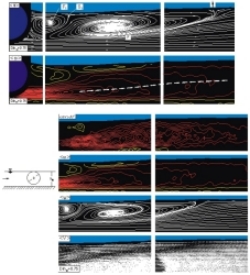You are here
Home ›Near-Wake Structure of a Cylinder in Shallow Water under the Influence of Bed Roughness Elements
Near-wake structure of a cylinder in shallow water under the influence of bed roughness elements. The images in the left column show the streamline topology immediately adjacent to the bed (bottom surface), corresponding to hL/hw = 0.04. The images in the right column show patterns of Reynolds stress at the midplane, hL/hw = 0.5. The streamline topology immediately adjacent to the bed in absence of roughness shows two saddle points, S1 and S2 and two foci F1 and F2. This topology corresponds to an owl face of the first kind. In presence of roughness of small height, hr/hw = 0.062, shown in the middle image, the owl face pattern retains its generic features. In fact, for the largest height roughness hr/hw = 0.25, two saddle points and two foci are maintained, even though the saddle point S2 has moved downstream substantially. The corresponding patterns of <u'v'>/U2 in the right column show a substantial decrease in peak value for roughness of small height hr/hw = 0.062, represented in the middle image, relative to the reference case of no roughness, hr/hw = 0. Furthermore, for a larger roughness, height hr/hw = 0.25, represented in the bottom image, a further reduction in peak value of <u'v'>/U2 , as well as downstream movement of this peak, is evident. These modifications of the patterns of Reynolds stress correspond to varying degrees of attenuation of the large-scale vortex formation in the near-wake region (not shown). D/hw = 2, Re = UD/ν = 4498 and S = cfD/hw =0.027.

Vortex formation from a vertical cylinder in shallow water is controlled by placement of a narrow transverse strip of roughness elements on the bed (bottom surface). A technique of high-image-density particle image velocimetry is employed to obtain global, instantaneous representations of the flow patterns, which lead to phase- and time-averaged patterns of streamline topology and Reynolds stress on planes at and above the bed. Near the bed, the overall form of the streamline topology is maintained, even at larger heights of the roughness elements. With increasing height of the elements, the downstream saddle point is further displaced in the streamwise direction. Correspondingly, the streamwise extent of the negative pocket of the streamwise velocity component, i.e., the region of reverse flow along the bed surface, increases substantially in the streamwise direction.
The Reynolds stress in the very near-wake, at locations upstream of the roughness elements, is significantly attenuated, even for small height of the roughness. This attenuation occurs not only near the bed surface, but also at the midplane of the shallow water wake, and thereby indicates that the consequence of localized roughness is to exert a global influence. In fact, corresponding patterns of instantaneous velocity and vorticity indicate that consistent formation of large-scale vortices in the very near-wake region is attenuated with relatively small surface roughness on the bed.
Downstream of the roughness elements, the patterns of Reynolds stress near the bed surface, as well as at the midplane of the water layer, are significantly altered relative to the case of no roughness. Near the bed, highly concentrated patterns of positive and negative Reynolds stress in absence of roughness give way to lower level regions of Reynolds stress, in the form of alternating concentrations; the particular pattern depends on the height of the roughness elements. At the midplane of the water layer, the Reynolds stress patterns maintain their same overall form, but the extrema of the Reynolds stress concentrations are attenuated in magnitude and are shifted in the downstream direction, with increasing height of the roughness elements. These observations are complemented by patterns of instantaneous velocity and vorticity.
